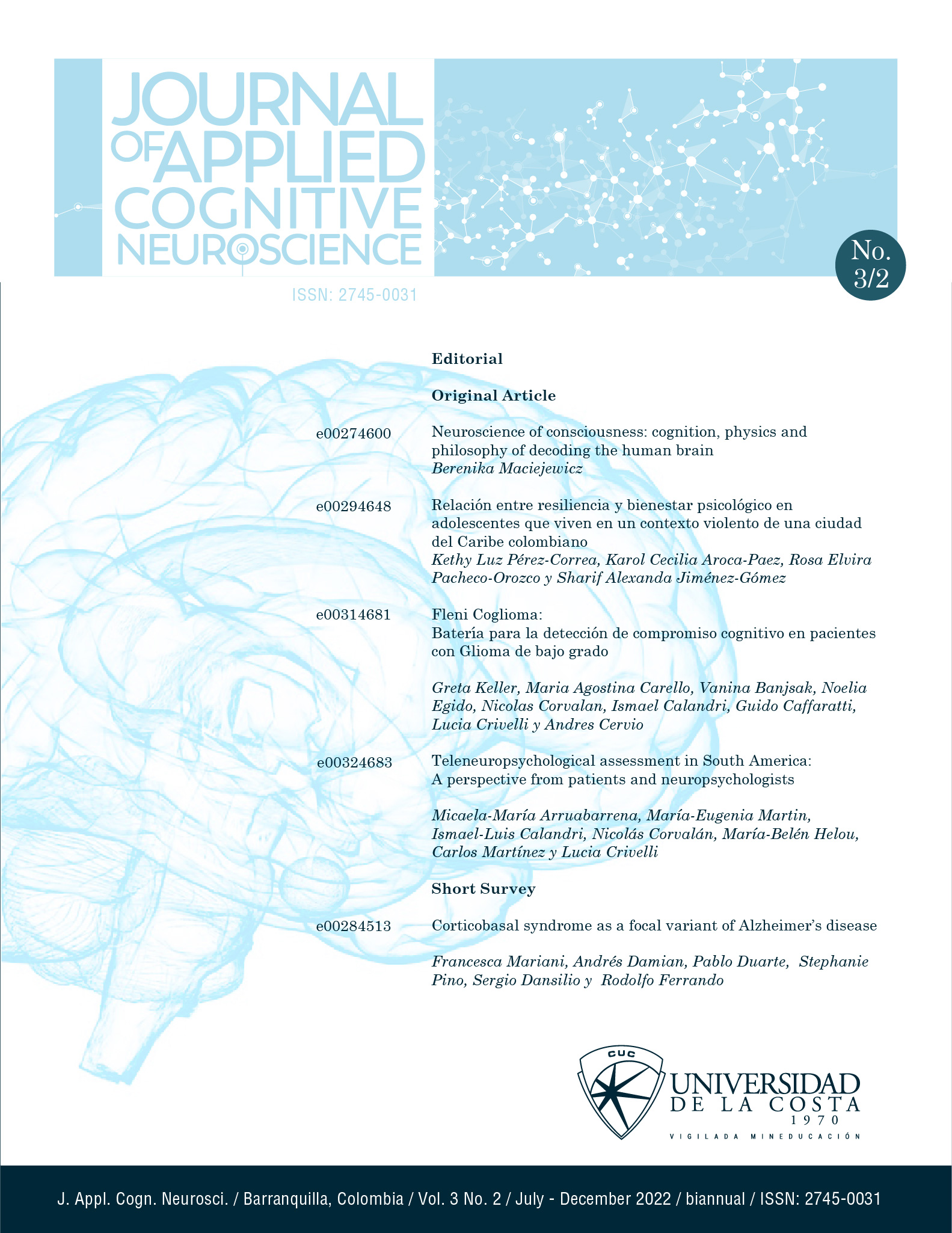Fleni CoGlioma: Battery for the detection of cognitive compromise in patients with low grade Glioma
DOI:
https://doi.org/10.17981/JACN.3.2.2022.04Keywords:
Lesion, Tumor, Glioma, Neuropsychology, EvaluationAbstract
New surgical procedures have benefited patients with Low-Grade Gliomas (LGG), who have a longer life expectancy. For this reason there is a growing interest in protecting cognition and improving their quality of life. The objectives of the study were: (1) To construct and administer a neuropsychological battery to examine the pre-surgical cognitive profile in patients with LGG and to determine the post-surgical effects. (2) To design an intra-surgical intervention for patients with lesions in the left hemisphere in order to minimize possible later deficits. 19 patients were evaluated with a pre-surgical battery that assesses different cognitive domains: memory, language, attention, executive functions, visuospatial skills, social cognition, praxias and gnosias. Patients also completed neuropsychiatric questionnaires to assess functionality, mood and quality of life. Patients presented deficits in multiple cognitive domains in the pre-surgical evaluation, when comparing their performance with normative values adjusted for age, sex and education. The results of the present study demonstrate the importance of the administration of the neuropsychological battery specifically designed for LGG patients and the assessment of cognitive domains to achieve detection and follow-up of possible cognitive disorders.
Downloads
References
Acevedo-Vergara, K.; Perez-Florez, M.; Ramirez, A.; Torres-Bayona, S.; Dau, A.; Salva, S.; Maloof, D.; Garcia, C.; Luque, M. & Felipe Guillen-Burgos, H. (2022). Cognitive deficits in adult patients with high-grade glioma: A systematic review. Clinical neurology and neurosurgery, 219, 1–10.
https://doi.org/10.1016/j.clineuro.2022.107296
Ahmadi, R.; Dictus, C.; Hartmann, C.; Zürn, O.; Edler, L.; Hartmann, M.; Combs, S.; Herold-Mende, C.; Wirtz, C. R. & Unterberg, A. (2009). Long-term outcome and survival of surgically treated supratentorial low-grade glioma in adult patients. Acta neurochirurgica, 151(11), 1359–1365.
https://doi.org/10.1007/s00701-009-0435-x
Anderson, S. W.; Bechara, A.; Damasio, H.; Tranel, D. & Damasio, A. R. (1999). Impairment of social and moral behavior related to early damage in human prefrontal cortex. Nature neuroscience, 2(11), 1032–1037.
Barzilai, O.; Ben Moshe, S.; Sitt, R.; Sela, G.; Shofty, B. & Ram, Z. (2018). Improvement in cognitive function after surgery for low-grade glioma. Journal of neurosurgery, 130(2), 426–434.
https://doi.org/10.3171/2017.9.JNS17658
Benton, A.; Hannay, H. J. & Varney, N. R. (1975). Visual perception of line direction in patients with unilateral brain disease. Neurology, 25(10), 907–910.
https://doi.org/10.1212/wnl.25.10.907
Berry, D. T. R.; Allen, R. S.; Schmitt & Frederick, A. (1991). Rey-Osterrieth complex figure: Psychometric characteristics in a geriatric sample. Clinical Neuropsychologist, 5(2), 143–153.
https://doi.org/10.1080/13854049108403298
Bird, C. M.; Papadopoulou, K.; Ricciardelli, P.; Rossor, M. N. & Cipolotti, L. (2004). Monitoring cognitive changes: psychometric properties of six cognitive tests. British Journal of Clinical Psychology, 43(2), 197–210.
https://doi.org/10.1348/014466504323088051
Bu, L.; Lu, J.; Zhang, J. & Wu, J. (2021). Intraoperative Cognitive Mapping Tasks for Direct Electrical Stimulation in Clinical and Neuroscientific Contexts. Frontiers in human neuroscience, 15, 1–10.
https://doi.org/10.3389/fnhum.2021.612891
Cabrera, S.; Edelstein, K.; Mason, W. P. & Tartaglia, M. C. (2016). Assessing behavioral syndromes in patients with brain tumors using the frontal systems behavior scale (FrSBe). Neuro-oncology practice, 3(2), 113–119.
https://doi.org/10.1093/nop/npv055
Cázares, F.; Quiceno, J. & Montoya, B. (2016). Preparación psicológica para la intervención quirúrgica: Revisión sistemática de la literatura. Psychologia. Avances de la Disciplina, 10(2), 73–85.
https://doi.org/10.21500/19002386.2480
Cochereau, J.; Lemaitre, A.-L.; Wager, M.; Moritz-Gasser, S.; Duffau, H. & Herbet, G. (2020). Network-behavior mapping of lasting executive impairments after low-grade glioma surgery. Brain structure & function, 225(8), 2415–2429.
https://doi.org/10.1007/s00429-020-02131-5
Collée, E.; Vincent, A.; Dirven, C. & Satoer, D. (2022). Speech and Language Errors during Awake Brain Surgery and Postoperative Language Outcome in Glioma Patients: A Systematic Review. Cancers, 14(21), 1–16.
https://doi.org/10.3390/cancers14215466
Cowan, N. (2008). What are the differences between long-term, short-term, and working memory? Progress in brain research, 169, 323–338.
https://doi.org/10.1016/S0079-6123(07)00020-9
Craft, S.; Newcomer, J.; Kanne, S.; Dagogo-Jack, S.; Cryer, P.; Sheline, Y.; Luby, J.; Dagogo-Jack, A. & Alderson, A. (1996). Memory improvement following induced hyperinsulinemia in Alzheimer’s disease. Neurobiology of aging, 17(1), 123–130.
https://doi.org/10.1016/0197-4580(95)02002-0
Cummings, J. L.; Mega, M.; Gray, K.; Rosenberg-Thompson, S.; Carusi, D. A. & Gornbein, J. (1994). The Neuropsychiatric Inventory: comprehensive assessment of psychopathology in dementia. Neurology, 44(12), 2308–2314.
https://doi.org/10.1212/wnl.44.12.2308
De Sousa, S.; Malloy-Diniz, L. F. & Hamdan, A. C. (2012). Validity convergent and reliability test-retest of the Rey Auditory Verbal Learning Test. Clinical Neuropsychiatry: Journal of Treatment Evaluation, 9(3), 129–137. Available:
Della, S.; Laiacona, M.; Spinnler, H. & Trivelli, C. (1995). Poppelreuter-Ghent’s Overlapping Figures Test: its sensitivity to age, and its clinical use. Archives of clinical neuropsychology: the official journal of the National Academy of Neuropsychologists, 10(6), 511–534.
https://doi.org/10.1016/0887-6177(94)00049-v
Diamond, A. (2013). Executive functions. Annual review of psychology, 64, 135–168.
https://doi.org/10.1146/annurev-psych-113011-143750
Duffau, H. (2021). New Philosophy, Clinical Pearls, and Methods for Intraoperative Cognition Mapping and Monitoring “à la carte” in Brain Tumor Patients. Neurosurgery, 88(5), 919–930.
https://doi.org/10.1093/neuros/nyaa363
Duffau, H. (2014). The huge plastic potential of adult brain and the role of connectomics: new insights provided by serial mappings in glioma surgery. Cortex, 58, 325–337.
https://doi.org/10.1016/j.cortex.2013.08.005
Duffau, H.; Lopes, M.; Arthuis, F.; Bitar, A.; Sichez, J.-P.; Van Effenterre, R. & Capelle, L. (2005). Contribution of intraoperative electrical stimulations in surgery of low grade gliomas: a comparative study between two series without (1985-96) and with (1996-2003) functional mapping in the same institution. Journal of neurology, neurosurgery, and psychiatry, 76(6), 845–851.
https://doi.org/10.1136/jnnp.2004.048520
Figarella-Branger, D.; Appay, R.; Metais, A.; Tauziède-Espariat, A.; Colin, C.; Rousseau, A. & Varlet, P. (2022). La classification de l’OMS 2021 des tumeurs du système nerveux central. The 2021 WHO classification of tumours of the central nervous system. Annales de pathologie, 42(5), 367–382.
https://doi.org/10.1016/j.annpat.2021.11.005
Foundas, A. L. (2013). Apraxia: neural mechanisms and functional recovery. Handbook of clinical neurology, 110, 335–345.
https://doi.org/10.1016/B978-0-444-52901-5.00028-9
Grant, D. A. & Berg, E. A. (1948). Wisconsin Card Sorting Test [Database]. APT.
https://doi.org/10.1037/t31298-000
Grier, J. T. & Batchelor, T. (2006). Low-grade gliomas in adults. The oncologist, 11(6), 681–693.
https://doi.org/10.1634/theoncologist.11-6-681
Grossberg, S. (2021). Attention: Multiple types, brain resonances, psychological functions, and conscious states. Journal of integrative neuroscience, 20(1), 197–232.
https://doi.org/10.31083/j.jin.2021.01.406
Henry, M. L. & Grasso, S. M. (2018). Assessment of Individuals with Primary Progressive Aphasia. Seminars in speech and language, 39(3), 231–241.
https://doi.org/10.1055/s-0038-1660782
Herbet, G. (2021). Should Complex Cognitive Functions Be Mapped With Direct Electrostimulation in Wide-Awake Surgery? A Network Perspective. Frontiers in neurology, 12, 1–5.
https://doi.org/10.3389/fneur.2021.635439
Hervey-Jumper, S. L.; Li, J.; Osorio, J. A.; Lau, D.; Molinaro, A. M.; Benet, A. & Berger, M. S. (2016). Surgical assessment of the insula. Part 2: validation of the Berger-Sanai zone classification system for predicting extent of glioma resection. Journal of Neurosurgery JNS, 124(2), 482–488.
https://doi.org/10.3171/2015.4.JNS1521
Jehna, M.; Becker, J.; Zaar, K.; von Campe, G.; Mahdy Ali, K.; Reishofer, G.; Payer, F.; Synowitz, M.; Fazekas, F.; Enzinger, C. & Deutschmann, H. (2017). Symmetry of the arcuate fasciculus and its impact on language performance of patients with brain tumors in the language-dominant hemisphere. Journal of neurosurgery, 127(6), 1407–1416.
https://doi.org/10.3171/2016.9.JNS161281
Keles, G. E.; Lamborn, K. R. & Berger, M. S. (2001). Low-grade hemispheric gliomas in adults: a critical review of extent of resection as a factor influencing outcome. Journal of neurosurgery, 95(5), 735–745.
https://doi.org/10.3171/jns.2001.95.5.0735
Klein, M. (2012). Neurocognitive functioning in adult WHO grade II gliomas: impact of old and new treatment modalities. Neuro-oncology, 14(Suppl 4), iv17–iv24.
https://doi.org/10.1093/neuonc/nos161
Kopp, B.; Lange, F. & Steinke A. (2021). The Reliability of the Wisconsin Card Sorting Test in Clinical Practice. Assessment, 28(1), 248–263.
https://doi.org/10.1177/1073191119866257
Kumthekar, P.; Raizer, J. & Singh, S. (2015). Low-grade glioma. In J. Raizer & A. Parsa (eds), Cancer treatment and research (pp. 75–87). Springer.
https://doi.org/10.1007/978-3-319-12048-5_5
Latini, F.; Axelson, H.; Fahlström, M.; Jemstedt, M.; Alberius Munkhammar, Å.; Zetterling, M. & Ryttlefors, M. (2021). Role of Preoperative Assessment in Predicting Tumor-Induced Plasticity in Patients with Diffuse Gliomas. Journal of clinical medicine, 10(5), 1–25.
https://doi.org/10.3390/jcm10051108
Leal, R. T. M.; Barcellos, B. M. & Landeiro, J. A. (2018). Technical Aspects of Awake Craniotomy with Mapping for Brain Tumors in a Limited Resource Setting. World neurosurgery, 113, 67–72.
https://doi.org/10.1016/j.wneu.2018.02.013
Leiguarda, R., Clarens, F., Amengual, A., Drucaroff, L. & Hallett, M. (2014). Short apraxia screening test. JCEN, 36(8), 867–874.
https://doi.org/10.1080/13803395.2014.951315
Lemaitre, A.-L.; Herbet, G.; Ng, S.; Moritz-Gasser, S. & Duffau, H. (2022). Cognitive preservation following awake mapping-based neurosurgery for low-grade gliomas: A longitudinal, within-patient design study. Neuro-Oncology, 24(5), 781–793.
https://doi.org/10.1093/neuonc/noab275
Louis, D. N.; Perry, A.; Reifenberger, G.; Von Deimling, A.; Figarella-Branger, D.; Cavenee, W. K.; Ohgaki, H.; Wiestler, O. D.; Kleihues, P. & Ellison, D. W. (2016). The 2016 World Health Organization Classification of Tumors of the Central Nervous System: a summary. Acta neuropathologica, 131(6), 803–820.
https://doi.org/10.1007/s00401-016-1545-1
Luria, A. R. (1962). Atención y memoria. Martínez Roca.
Mandonnet, E. (2021). Should Complex Cognitive Functions Be Mapped With Direct Electrostimulation in Wide-Awake Surgery? A Commentary. Frontiers in neurology, 12, 1–4.
https://doi.org/10.3389/fneur.2021.721038
Mesulam, M.-M.; Thompson, C. K.; Weintraub, S. & Rogalski, E. J. (2015). The Wernicke conundrum and the anatomy of language comprehension in primary progressive aphasia. Brain: a journal of neurology, 138(8), 2423–2437.
https://doi.org/10.1093/brain/awv154
Niki, C.; Kumada, T.; Maruyama, T.; Tamura, M.; Kawamata, T. & Muragaki, Y. (2020). Primary Cognitive Factors Impaired after Glioma Surgery and Associated Brain Regions. Behavioural neurology, 1–9.
https://doi.org/10.1155/2020/7941689
Olderbak, S.; Wilhelm, O.; Olaru, G.; Geiger, M.; Brenneman, M. W. & Roberts, R. D. (2015). A psychometric analysis of the reading the mind in the eyes test: toward a brief form for research and applied settings. Frontiers in Psychology, 6, 1–14.
https://doi.org/10.3389/fpsyg.2015.01503
Osterrieth, P. A. (1944). Le test du copie d’une figure complexe: Contribution à l'étude de la perception et de la mémoire. Archives of Psychology, 30, 206–356.
Paci, M.; Lorenzini, C.; Fioravanti, E.; Poli, C. & Lombardi, B. (2015). Reliability of the 36-item version of the Token Test in patients with poststroke aphasia. Top Stroke Rehabil, 22(5), 374–376.
https://doi.org/10.1179/1074935714Z.0000000049
Park, H.-J. & Friston, K. (2013). Structural and functional brain networks: from connections to cognition. Science (New York, N.Y.), 342(6158), 579-1–579-8.
https://doi.org/10.1126/science.1238411
Pedraza, O.; Sachs, B. C.; Ferman, T. J.; Rush, B. K. & Lucas, J. A. (2011). Difficulty and discrimination parameters of Boston naming test items in a consecutive clinical series. Archives of Clinical Neuropsychology, 26(5), 434–444.
https://doi.org/10.1093/arclin/acr042
Periáñez, J. A.; Lubrini, G.; García-Gutiérrez, A. & Ríos-Lago, M. (2021). Construct Validity of the Stroop Color-Word Test: Influence of Speed of Visual Search, Verbal Fluency, Working Memory, Cognitive Flexibility, and Conflict Monitoring. Archives of Clinical Neuropsychology, 36(1), 99–111.
https://doi.org/10.1093/arclin/acaa034
Poulin-Dubois, D. (2020). Theory of mind development: State of the science and future directions. Progress in brain research, 254, 141–166.
https://doi.org/10.1016/bs.pbr.2020.05.021
Reitan, R. M. (1958). Validity of the Trail Making Test as an Indicator of Organic Brain Damage. Perceptual and Motor Skills, 8, 271–276.
https://doi.org/10.2466/pms.1958.8.3.271
Rey, A. (1964). L’examen clinique en Psychologia. Pressee Universitaires de France.
Richardson, J. T. (2007). Measures of short-term memory: a historical review. Cortex, 43(5), 635–650.
https://doi.org/10.1016/s0010-9452(08)70493-3
Rofes, A. & Miceli, G. (2014). Language mapping with verbs and sentences in awake surgery: a review. Neuropsychology review, 24(2), 185–199.
https://doi.org/10.1007/s11065-014-9258-5
Roman, F. N.; Rojas, G.; Román, N.; Iturry, M.; Blanco, R.; Leis, A.; Bartoloni, L.; Allegri R. F. & Grupo de trabajo Programa Argecog (2014). Baremos Test de la Mirada. Revista, Neuropsicología y Latinoamericana, 4(3), 1–5. Disponible en https://www.neuropsicolatina.org/index.php/Neuropsicologia_Latinoamericana/article/view/108
Sanai, N.; Mirzadeh, Z. & Berger, M. S. (2008). Functional outcome after language mapping for glioma resection. The New England journal of medicine, 358(1), 18–27.
https://doi.org/10.1056/NEJMoa067819
Sanai, N.; Chang, S. & Berger, M. S. (2011). Low-grade gliomas in adults. Journal of neurosurgery, 115(5), 948–965.
https://doi.org/10.3171/2011.7.JNS101238
Sánchez-Cubillo, I.; Periañez, J. A.; Adrover-Roig, D.; Rodríguez-Sánchez, J. M.; Ríos-Lago, M.; Tirapu, J. & Barceló, F. (2009). Construct validity of the Trail Making Test: Role of task-switching, working memory, inhibition/interference control, and visuomotor abilities. Journal of the International Neuropsychological Society, 15, 438–450.
https://doi.org/10.1017/S1355617709090626
Sanz, A.; Olivares, M. E. & Barcia, J. A. (2011). Aspectos Neuropsicológicos en Pacientes Diagnosticados de Tumores Cerebral. Clínica y Salud, 22(2), 139–155.
https://doi.org/10.5093/cl2011v22n2a4
Satoer, D.; Vincent, A.; Smits, M.; Dirven, C. & Visch-Brink, E. (2013). Spontaneous speech of patients with gliomas in eloquent areas before and early after surgery. Acta neurochirurgica, 155(4), 685–692.
https://doi.org/10.1007/s00701-013-1638-8
Satoer, D.; Visch-Brink, E.; Smits, M.; Kloet, A.; Looman, C.; Dirven, C. & Vincent, A. (2014). Long-term evaluation of cognition after glioma surgery in eloquent areas. Journal of neuro-oncology, 116(1), 153–160.
https://doi.org/10.1007/s11060-013-1275-3
Satoer, D.; Vork, J.; Visch-Brink, E.; Smits, M.; Dirven, C. & Vincent, A. (2012). Cognitive functioning early after surgery of gliomas in eloquent areas. Journal of neurosurgery, 117(5), 831–838.
https://doi.org/10.3171/2012.7.JNS12263
Seidel, K.; Szelényi, A. & Bello, L. (2022). Intraoperative mapping and monitoring during brain tumor surgeries. Handbook of clinical neurology, 186, 133–149.
https://doi.org/10.1016/b978-0-12-819826-1.00013-2
Shen, C.; Bao, W. M.; Yang, B. J.; Xie, R.; Cao, X. Y.; Luan, S. H. & Mao, Y. (2012). Cognitive deficits in patients with brain tumor. Chinese medical journal, 125(14), 2610–2617.
https://doi.org/10.3760/cma.j.issn.0366-6999.2012.14.037
Stroop, J. R. (1935). Studies of Interference in Serial Verbal Reactions. Journal of Experimental Psychology, 18, 643–662.
https://doi.org/10.1037/h0054651
Sung, E. (2011). The Reliability and Validity of Short-term and Working Memory Pointing Tasks Developed for Clinical Populations with Speech and Language Disorders. Communication Sciences & Disorders, 16(2), 185–201. Available from https://www.e-csd.org/upload/16-2_7.pdf
Tate, M. C.; Herbet, G.; Moritz-Gasser, S.; Tate, J. E. & Duffau, H. (2014). Probabilistic map of critical functional regions of the human cerebral cortex: Broca’s area revisited. Brain: a journal of neurology, 137(10), 2773–2782.
https://doi.org/10.1093/brain/awu168
Tirapu, J. (2007). La evaluación neuropsicológica. Psychosocial Intervention, 16(2), 189–211.
https://dx.doi.org/10.4321/S1132-05592007000200005
Umezaki, S.; Shinoda, Y.; Mukasa, A.; Tanaka, S.; Takayanagi, S.; Oka, H.; Tagawa, H.; Haga, N. & Yoshino, M. (2020). Factors associated with health-related quality of life in patients with glioma: impact of symptoms and implications for rehabilitation. Japanese journal of clinical oncology, 50(9), 990–998.
https://doi.org/10.1093/jjco/hyaa068.
Villarreal, S.; Linnavuo, M.; Sepponen, R.; Vuori, O.; Jokinen, H. & Hietanen, M. (2020). Dual-Task in Large Perceptual Space Reveals Subclinical Hemispatial Neglect. Journal of the International Neuropsychological Society: JINS, 26(10), 993–1005.
https://doi.org/10.1017/S1355617720000508
Weitzner, M. A.; Meyers, C. A.; Gelke, C. K.; Byrne, K. S.; Cella, D. F. & Levin, V. A. (1995). The Functional Assessment of Cancer Therapy (FACT) Scale. Development of a Brain Subscale and Revalidation of the General Version (FACT-G) in Patients with Primary Brain Tumors. Cancer, 75, 1151–1161.
https://doi.org/10.1002/1097-0142(19950301)75:5%3C1151::aid-cncr2820750515%3E3.0.co;2-q
Wechsler, D. & Stone, C. P. (1987). Wechsler Memory Scale. The Psychological Corporation.
Wollesen, B.; Fricke, M.; Jansen, C. P.; Gordt, K.; Schwenk, M.; Muehlbauer, T.; Morawietz, C.; Kruse, A. & Gramann, K. (2020). A three-armed cognitive-motor exercise intervention to increase spatial orientation and life-space mobility in nursing home residents: study protocol of a randomized controlled trial in the PROfit project. BMC geriatrics, 20(1), 1–15.
https://doi.org/10.1186/s12877-020-01840-0.
Wu, J.; Lu, J.; Zhang, H.; Zhang, J.; Mao, Y. & Zhou, L. (2015). Probabilistic map of language regions: challenge and implication. Brain: a journal of neurology, 138(3), 1–3.
https://doi.org/10.1093/brain/awu247
Zigmond, A. S. & Snaith, R. P. (1983). The hospital anxiety and depression scale. Acta psychiatrica Scandinavica, 67(6), 361–370.
Published
How to Cite
Issue
Section
License
Copyright (c) 2022 Journal of Applied Cognitive Neuroscience

This work is licensed under a Creative Commons Attribution-NonCommercial-NoDerivatives 4.0 International License.
You are free to:
- Share — copy and redistribute the material in any medium or format.
- The licensor cannot revoke these freedoms as long as you follow the license terms.
Under the following terms:
- Attribution — You must give appropriate credit, provide a link to the license, and indicate if changes were made. You may do so in any reasonable manner, but not in any way that suggests the licensor endorses you or your use.
- NonCommercial — You may not use the material for commercial purposes.
- NoDerivatives — If you remix, transform, or build upon the material, you may not distribute the modified material.
- No additional restrictions — You may not apply legal terms or technological measures that legally restrict others from doing anything the license permits.


 English
English
 Español (España)
Español (España)










